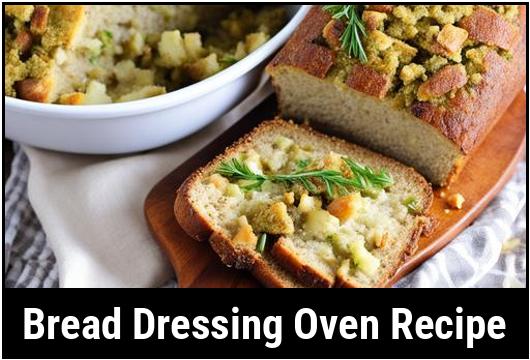
The Art Of Bread Dressing: An Oven Recipe Guide
Introduction – The Perfect Bread Dressing in Your Oven
Transforming a simple loaf of bread into a delectable dressing can elevate any meal. The comforting aroma, the variety of flavors, and the incredible versatility make bread dressing a beloved dish for any occasion. In this comprehensive guide, we will delve into the science behind bread dressing, explore culinary details, provide expert tips and variations, and cover everything you need to know about preparing, cooking, and perfecting your bread dressing recipe in the oven.
Food Science – Understanding the Magic of Bread Dressing
At the heart of a delicious bread dressing lies the captivating science behind it. The key factor that makes bread dressing so incredibly satisfying is the starch in the bread. When moistened, the starch molecules in bread absorb the liquid, resulting in a gel-like structure that provides a pleasing texture and helps bind the flavors together.
The oven plays a significant role in transforming bread dressing. As it bakes, the oven’s heat evaporates the moisture, leaving behind a perfectly browned and crispy crust while retaining the desired moisture within the dressing. Understanding this delicate balance is crucial for achieving a mouthwatering bread dressing every time.
Selection and Cleaning – Choosing the Perfect Bread
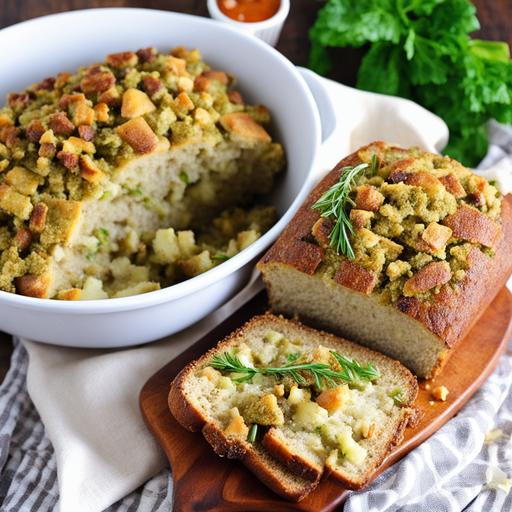
Before diving into the detailed preparation, let’s ensure we select the best bread for our dressing masterpiece. Opt for a bread with a denser texture, such as a French baguette, sourdough, or ciabatta bread. This type of bread offers a robust structure that will hold up well to the moisture and ingredients added during the dressing preparation.
When cleaning the bread, make sure to remove any mold or other imperfections before use. If the bread is slightly stale or dry, don’t fret — it can actually work to your advantage, as it will better absorb the flavors and moisture during the cooking process.
Preparation – The Path to Bread Dressing Delight
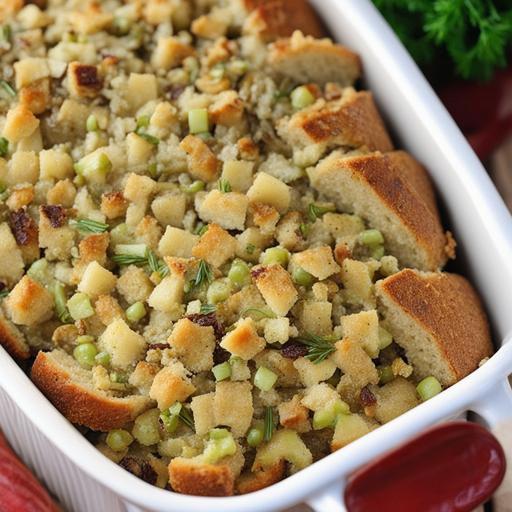
Step 1: Gathering the Ingredients
To embark on your bread dressing journey, gather the following ingredients:
-
1 loaf of the bread of your choice
-
4 cups of chicken or vegetable broth
-
1 cup of diced onions
-
1 cup of diced celery
-
1 cup of diced carrots
-
4 cloves of minced garlic
-
1 teaspoon of dried thyme
-
1 teaspoon of dried sage
-
1 teaspoon of dried rosemary
-
Salt and pepper to taste
Step 2: Preparing the Loaf
Begin by preheating your oven to 350°F (175°C). While the oven is warming up, slice the loaf of bread into small cubes, roughly 1-inch in size. Arrange the cubes on a baking sheet and let them dry in the oven for approximately 15-20 minutes. This step helps remove excess moisture from the bread cubes, allowing them to absorb the flavors of the dressing more effectively.
Step 3: Sautéing the Vegetables and Flavors
In a large skillet over medium heat, sauté the onions, celery, carrots, and minced garlic until they become tender and fragrant, usually around 5-7 minutes. This process enhances the flavors, adding depth to the final dressing.
Step 4: Mixing the Dressing
In a large mixing bowl, combine the sautéed vegetables, dried herbs (thyme, sage, rosemary), and the dried bread cubes. Gradually pour the broth over the mixture, stirring gently until the ingredients are evenly distributed. Allow the mixture to rest for a few minutes, allowing the bread cubes to absorb the aromatic liquid fully.
Step 5: Seasoning and Adjusting Consistency
Taste the mixture and season with salt and pepper to your liking. If the dressing seems too dry, add additional broth to achieve a moist, yet not soaked, consistency.
Tips and Variations – Unleashing Your Creativity
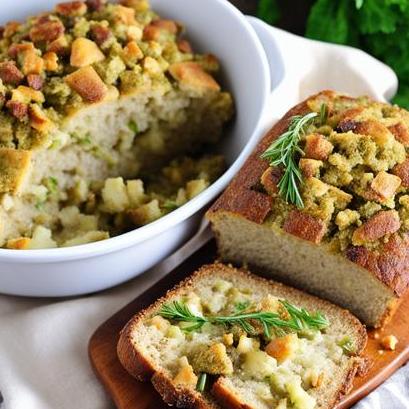
While the basic bread dressing recipe is a classic, limitless opportunities exist to tailor the dish to your tastes and preferences. Here are some tips and variations to help you create a truly customized bread dressing experience:
-
Choosing Seasonings: Experiment with different herbs and spices, such as oregano, parsley, thyme, or even a touch of paprika, for unique and flavorful combinations.
-
Enhancing Flavors: Amp up the savory factor by adding crumbled bacon, cooked sausage, or sautéed mushrooms to your dressing mix.
-
Incorporating Fruits: Consider adding diced apples, dried cranberries, or raisins to introduce a delightful sweetness and contrast in texture to your dressing.
-
Playing with Nuts: Toasted pecans, walnuts, or hazelnuts bring a delightful crunch and richness to the dressing.
With these tips in your culinary arsenal, the possibilities for your bread dressing creations are endless. Dare to experiment and get creative!
Doneness Checks – Achieving Perfection with Precise Timing
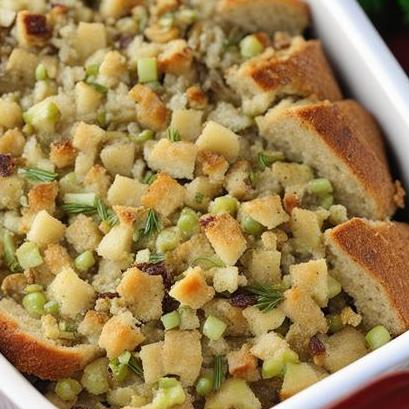
Achieving the perfect doneness is crucial for a pleasurable bread dressing experience. You want a dressing that is moist, flavorful, and heated through while maintaining its appealing texture. To ensure your dressing reaches its full potential, consider the following doneness checks:
-
Internal Temperature: Insert an instant-read meat thermometer into the center of the dressing, aiming for a temperature of 160°F (71°C). This ensures all potential harmful bacteria are eliminated, guaranteeing a safe and enjoyable dish.
-
Texture and Moisture: A well-cooked dressing should have a slightly crispy exterior while maintaining a moist interior. Test a few bread cubes from the center of the dish for the desired texture and moistness.
Overcooking and Undercooking – Challenges and Solutions
Though you strive for perfection, occasional mishaps happen in the kitchen. Overcooked or undercooked bread dressing can still be saved with a little creativity and ingenuity. Here are some solutions for these common challenges:
Overcooked: If your dressing turns out a bit on the dry side, try lightly drizzling warmed broth over the top before serving. Additional moisture will help rehydrate the bread, enhancing its overall texture and flavor.
Undercooked: In the event of an undercooked dressing, simply return it to the oven and bake it for an additional 10-15 minutes. Keep an eye on the color and texture while baking, ensuring it reaches the desired doneness without drying out excessively.
The Bread Dressing Oven Recipe – Bringing It All Together
Now that we’ve covered the food science, preparation, tips, and potential challenges, it’s time to assemble the comprehensive bread dressing oven recipe:
Ingredients:
-
1 loaf of bread (French baguette, sourdough, or ciabatta)
-
4 cups of chicken or vegetable broth
-
1 cup of diced onions
-
1 cup of diced celery
-
1 cup of diced carrots
-
4 cloves of minced garlic
-
1 teaspoon of dried thyme
-
1 teaspoon of dried sage
-
1 teaspoon of dried rosemary
-
Salt and pepper to taste
Instructions:
-
Preheat your oven to 350°F (175°C).
-
Slice the loaf of bread into 1-inch cubes and place them on a baking sheet.
-
Bake the bread cubes in the oven for 15-20 minutes, allowing them to dry.
-
In a large skillet over medium heat, sauté the onions, celery, carrots, and minced garlic until tender and fragrant.
-
In a large mixing bowl, combine the sautéed vegetables, dried herbs, and bread cubes.
-
Gradually pour the broth over the mixture, stirring until evenly distributed.
-
Allow the mixture to rest and absorb the liquid for a few minutes.
-
Season with salt and pepper to taste.
-
Adjust the dressing’s moisture level by adding more broth if necessary.
-
Transfer the mixture to a baking dish.
-
Bake in the preheated oven for approximately 45-50 minutes, or until the internal temperature reaches 160°F (71°C), and the desired texture is achieved.
-
Remove from the oven and let it cool slightly before serving your delightful bread dressing.
Conclusion – A Festive and Indulgent Delight
Bread dressing, with its warm, comforting flavors and endless customization possibilities, is a delightful addition to any feast or everyday dining experience. Armed with the knowledge of food science, culinary details, preparation techniques, tips, and variations, you are now equipped to create your own perfect loaf of bread dressing in your oven. Embrace creativity, experiment with flavors, and savor the joy of preparing and sharing this timeless dish with loved ones. Enjoy every bite of your mouthwatering bread dressing masterpiece!
Sources
FAQS On Bread Dressing Oven Recipe
How Long Should I Bake The Bread Dressing In The Oven?
Typically, bread dressing should be baked in the oven for around 30-45 minutes at a temperature of 350 degrees Fahrenheit. However, always check the recipe you are following for specific baking instructions.
Should I Cover The Bread Dressing While It Bakes In The Oven?
This depends on personal preference, but most recipes do recommend covering the bread dressing with foil for the first half of the baking time to prevent the top from getting too crispy.
How Do I Know When The Bread Dressing Is Fully Cooked?
The bread dressing should be golden brown on the top and a toothpick inserted in the center should come out clean. Additionally, the internal temperature should reach 165 degrees Fahrenheit to ensure it is fully cooked.
Can I Make This Bread Dressing Ahead Of Time And Reheat It In The Oven?
Yes, you can make the bread dressing ahead of time and store it in the refrigerator for up to 2 days. Reheat it in the oven at 350 degrees Fahrenheit for around 20-25 minutes, or until heated through.
Can I Use Any Type Of Bread For This Recipe?
While the type of bread used may affect the flavor, you can use any type of bread for this recipe. Stale bread or day-old bread works best as it has already dried out slightly, making it easier to absorb the liquid in the recipe.



